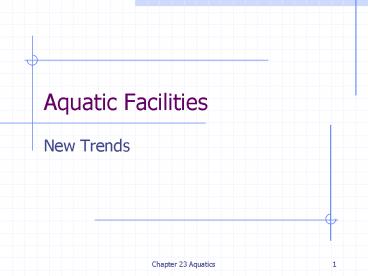Aquatic Facilities - PowerPoint PPT Presentation
1 / 23
Title: Aquatic Facilities
1
Aquatic Facilities
- New Trends
2
Major Growth in Aquatic Facilities
- Came after WWII good economy plus US was a
nation of non-swimmers prior to the war and
returned as a nation of swimmers following the
war. - Traditional, competitive pools built in the
1950-1970s - Waterparks and Leisure pools began in the USA in
the mid-1980s
3
- Leisure pools tend to recover significantly more
income than traditional competitive pools. - When planning a new facility, identifying the
priority user groups is of the utmost importance. - Visiting other relatively new aquatic facilities
is strongly recommended.
4
Outdoor vs. Indoor Pools
- Outdoor Pools less costly to construct but have a
2-3 month season. - Indoor Pools more costly but are open 12 months a
year.
5
Outdoor Pools Today
- Need to add an abundance of shade structures
- De-emphasize shallow water baby pools
- and now spraygrounds instead, without standing
water. - Outdoor pools use stabilized chlorines, indoor
pools must not.
6
Competitive Pools
- Somewhat easier to plan because dimensions are
similar. - 78 81 degrees F
- Springboards and Diving Towers need deep water
(12.5 17 feet). - Wider pool decks are desired but at great expense
because the footprint of the building is
expanded.
7
Pool Decks/Floors
- Tile is by far the most versatile finish but also
the most expensive. - Non-slips decks are a must and must be tested
first. - Fabric floor (carpet) and deck finishes are not
recommended for wet environments - (mold, mildew, bacteria, etc).
8
Deck drains
- Continuous trench drain vs. intermittent drains.
- Keep slot drains away from pool edge possible
contamination of pool water. - Deck must be sloped to drains.
9
Pool lighting (indoors)
- 125-150 foot candles recommended for new
facilities hosting elite competitive events - 100 foot candles for other competitions
- 30-50 foot candles for recreational and
non-competitive aquatics. - Should be able to switch to various light levels
for various user groups.
10
Indoor Lighting
- Place fixtures strategically for ease of
replacing bulbs. - Bulbs lose their brilliance quickly.
- Lights should not create glare of blind
competitors, patrons or lifeguards. - Windows/skylights add aesthetics while producing
glare and algae if not designed and installed
correctly.
11
Underwater Lighting
- Often required for safety and aesthetics
- Typically troublesome in pools leakage and
electrocutions.
12
Interior finishes
- Tile is best by far but also most expensive.
- Others finishes work well but stain and do not
last as long. - All pool finishes must be either white or very
light except for Diving Platform wells where dark
blue is often used.
13
Movable Floors
- Great for increased programming
- Expensive
- Can require maintenance
14
Indoor Air Quality
- Significant problem for energy efficient indoor
pools - Much fresh air is needed of good air quality
- The busier the pool the more likely it is to have
air quality issues. - ASHRAE standards may not be adequate14
15
Filtration
- Pressure vs. vacuum systems
- Media Types
- Sand, D.E., Cartridge, Glass, Zeolite
- Turnovers are important usually the faster the
turnover the better for filtration
16
Chemistry
- Chlorine
- Bromine
- Ozone
- U/V light
- Others (ionizers, chlorine generation, etc.)
17
Heating
- Gas
- Solar
- Combination
- others
18
Planning Leisure Aquatic Facilities
- Leisure pool movement arrived in the US
- in the 1980s.
- Successful in Europe and Canada prior to
acceptance in the USA, particularly indoors - Construction costs tend to range from 1-2
million for small communities (8,000 sq. ft.) to
up to 10 million for larger communities
(24,000sq. Ft.)
19
Income Generation
- Leisure pools tend to generate more income than
traditional pools - However, even the best managed leisure
- pools have a difficult time turning a true
profit - Food and Beverage Concessions tend to be large
income generators at leisure pools
20
Ancillary Areas
- Shade structures/areas
- Sand play areas
- Sun turf areas
- Concessions
- Seating areas
- Lanscaping/theming
21
Water Attractions
- Waterslides
- Lazy Rivers
- Water features/toys
- Multiple pools with different temperatures
22
Trends in Water Safety
- Supervision of the lifeguards is key.
- Video both land based and underwater
- Drowning detection systems using both computer
and video technology. - Larger lifeguard stations for movement
- 5 Minute Scanning Strategy
- 5/30 model of Aquatic Accountability
- AEDs, Oxygen, etc.
23
(No Transcript)







![get⚡[PDF]❤ Principles and Practices of Aquatic Law PowerPoint PPT Presentation](https://s3.amazonaws.com/images.powershow.com/10045134.th0.jpg?_=20240601072)























